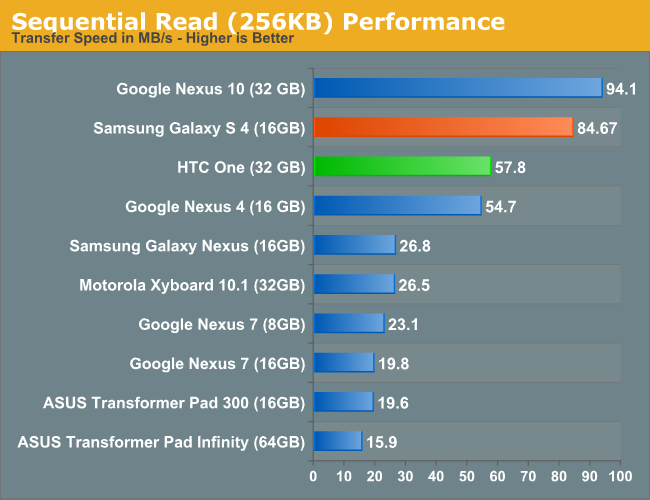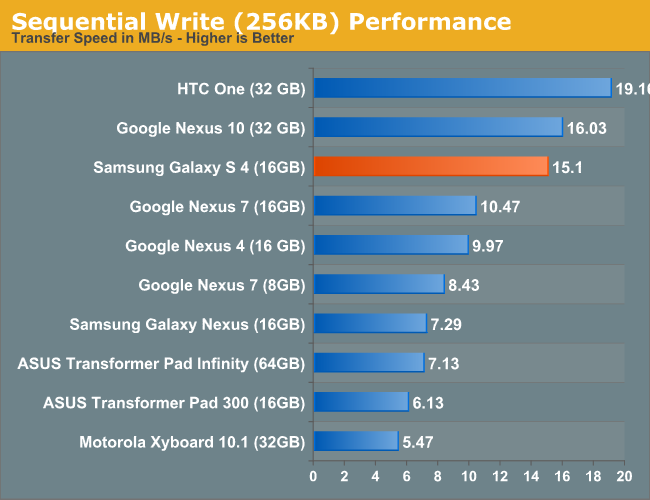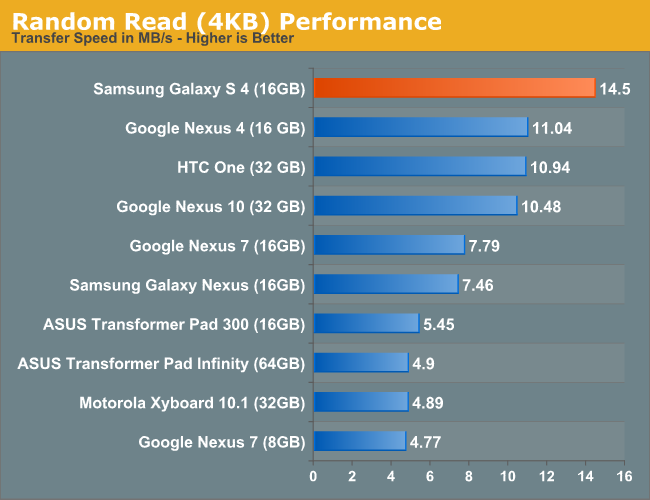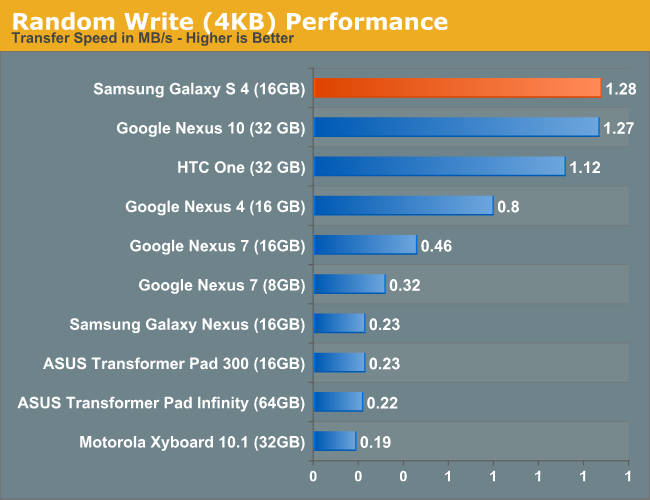Samsung Galaxy S 4 Review - Part 1
by Brian Klug on April 24, 2013 12:01 AM ESTNAND Performance
The Galaxy S 4 ships with either 16GB or 32GB of NAND on-board, but allows for expansion via a microSD card slot. The latter is a quickly disappearing feature on modern smartphones, but it remains a point of differentiation offered by Samsung. We were sampled a 16GB version of the Galaxy S 4, which arrived with 9.62GB of usable space after the OS and app pre-load.
As always we're using Androbench (with modified settings) to quantify NAND performance. Thankfully NAND performance has been steadily improving on modern smartphones/tablets, and the Galaxy S 4 is no exception. Sequential read performance actually sees a tremendous boost compared to most of the other devices in our charts here. Optimizing for sequential read performance makes a lot of sense, but it's good to see Samsung being competitive on all fronts here.
It is worth pointing out that NAND is treated very much as a commodity in these devices, and it's entirely possible that you'll see performance deviate from what we've shown here depending on what controller/NAND/firmware combination you get in your device.














335 Comments
View All Comments
Exodite - Wednesday, April 24, 2013 - link
The screen I'd imagine.The iPhone 5 has a screen that's ~65% the size, and ~35% of the resolution, of the one used by the Galaxy S4.
Its not the only reason of course but the screen matters a lot.
gnx - Wednesday, April 24, 2013 - link
Also a weakness of AMOLED. Since it needs to lighten up all subpixels max to get to white (and turns off all subpixels for gorgeous black). So web browsing, with so most sites having white background, really cranks up the power consumption of the display, hence the unexpectedly shorter battery life compared to other scenarios.sigmatau - Thursday, April 25, 2013 - link
I have a Nokia 900 with a Samsung sourced AMOLED plus which is beyond terrible outside on full brightness. I wonder how this one compares.lopri - Wednesday, April 24, 2013 - link
In that chart, iPhone 4S is leading Nexus 4. I have both and I call that bogus. Not sure what kind of iPhone 4S they've got.kmmatney - Wednesday, April 24, 2013 - link
We have mostly iPhones at my work, but a few SG3s. It's pretty easy to compare the real-use battery life at a conference, where we have to be on battery all day, and use are phones for normal stuff like email, texts, some web browsing, etc.. Without fail, the iPhones are all still going strong at the end of the day, while the SG3s have dead batteries. I was hoping the SGS4 would fix this, but I can't tell from the review. I hope the Note 3 increases the battery life.RealityMonster - Monday, April 29, 2013 - link
Apple has consistently refused to put tech in their phones unless they can still get 10hrs of battery life out of it. That's why the iPhone 5 is the first one to have LTE--the 4s just couldn't keep a charge long enough. Part of it is the form-factor, since a smaller phone means a smaller battery. Like other people have mentioned, though, the smaller screen is also a smaller power draw.So while you're never likely to see an iPhone that has a substantially better battery life than 10hrs under browsing conditions, you'll never see one that has a substantially lower life, either.
Gorgenapper - Tuesday, May 14, 2013 - link
That's a nice thing about Apple, they have a MUCH tighter control on their design and execution than Samsung ever could. People love to bash on Apple, and I admit that I'm not a big fan of many of Apple's decisions and products, but at least they know what they want to do, and go after it.Samsung, on the other hand, is more concerned with features, and less concerned with the quality of the execution of their overall product plan. I also get a vibe that Samsung caters more directly to the 'buy and throw away' mentality of most consumers, as OLEDs degrade at a faster rate than LCD (particularly blue subpixels), which was a reason why Samsung said that they used a pentile arrangement on the S3.
As for me, personally, I think I'll wait to see how the next gen iPhone looks like (rumored 4.5 ~ 4.8" screen), or more likely I'll wait to see how the next gen Nexus is. Assuming that I can't score a cheap 32gb Galaxy S4 after the big hype dies down.
mike55 - Wednesday, April 24, 2013 - link
I'm definitely torn between this and the HTC One. I'm also a bit disappointed that 32 GB of NAND isn't the standard minimum for flagship smartphones these days.Toss3 - Wednesday, April 24, 2013 - link
Both are great phones, but I'm buying the S4 because of the larger screen and smaller bezel. I also cannot stand the button layout of the HTC One. Was very surprised to see that the HTC One was very fluid, whereas the S4 stutters a bit. Especially considering the latter runs the SoC at a higher clockspeed. I also believe the camera of the S4 to be superior; even if the HTC One takes better night-shots, they're still not good enough for print or even watching on a 1080p TV(lots of noise and weird white-balance). The daylight shots from the S4 look pretty good, and are among the best of any phone right now.UpSpin - Wednesday, April 24, 2013 - link
4MP (2688x1520) translates to 22,76x12,87cm (8,96x5,067in) @ 300 DPI print resolution, I think that's enough. It's also above 1080p. People also forget that the HTC One contains a simple OIS!http://www.htc.com/www/zoe/stabilization/
But you're right, at best lightnig conditions, the S4 is superior, but I mostly never take pictures at best lightning conditions, but outside on a normal day, indoors poorly lit or indoors to scan documents.
According to other reviews the S4 stutters because of the gimmick features, once you turn off those advertised stuff, it should run better.